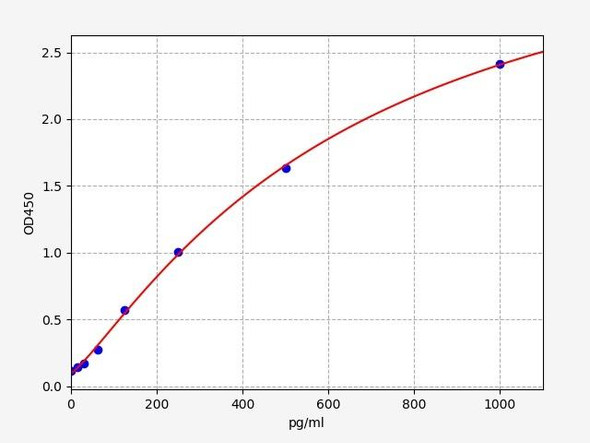Description
Human Ghrelin PharmaGenie ELISA - Kit Information
Obesity, which is characterized by excessive accumulation of adipose tissue in the body, has become one of the greatest public health challenges. Obesity is not only associated with health problems linked to increased weight-dependent pressure overload on lung, joints and bones, but also a important risk factor for life-threatening diseases such as cardiovascular diseases, type 2 diabetes and certain cancers. Ghrelin is synthesized as a preprohormone, and then proteolytically processed to yield a 28-amino acid peptide. Synthesis of ghrelin occurs predominantly in epithelial cells lining the fundus of the stomach, with smaller amounts produced in the placenta, kidney, pituitary and hypothalamus. Ghrelin has emerged as the first circulating hunger hormone. Ghrelin increases food intake and thus fat mass by an action exerted at the level of the hypothalamus. They activate cells in the arcuate nucleus that include the orexigenic neuropeptide Y (NPY) neurons. Ghrelin-responsiveness of these neurons is both leptin and insulin sensitive. Ghrelin also activates the mesolimbic cholinergic-dopaminergic reward link, a circuit that communicates the hedonic and reinforcing aspects of natural rewards, such as food. Ghrelin levels in the plasma of obese individuals are lower than those in leaner individuals except in the case of Prader-Willi syndrome-induced obesity. Those suffering from the eating disorder anorexia nervosa have high plasma levels of ghrelin compared to both the constitutionally thin and normal-weight controls. These findings suggest that ghrelin plays a role in both anorexia and obesity. Ghrelin levels are also high in patients who have cancer-induced cachexia.
Human Ghrelin PharmaGenie ELISA - Kit Data
| Product SKU: | SBRS0025 |
| Size: | 96T |
| Application: | Cross Reactivity: This ELISA kit shows no cross-reactivity with any of the cytokines tested: Nesfatin, Angiotensin II, NPY and APC. |
| Uniprot: | Q9UBU3 |
| Gene ID: | 51738 |
| Gene Names: | GHRL / MTLRP / UNQ524/PRO1066 |
| Synonyms: | Appetite-regulating hormone (Growth hormone secretagogue) (Growth hormone-releasing peptide) (Motilin-related peptide) (Protein M46) [Cleaved into: Ghrelin-27 Ghrelin-28 (Ghrelin) Obestatin] |
| Target Species: | Human, Mouse, Rat |
| Compatible Sample Types: | Cell Culture Supernatants, Serum |
| Design Principle: | Competition-based |
| Method of Detection: | Colorimetric |
| Quantitative/Semi-Quantitative: | Quantitative |
| Range: | 0.1-1,000 ng/ml |
| Sensitivity: | 161 pg/ml or 12.46 pM |
| Recommended Dilution: | Human: 4X, Mouse: 4X, Rat: 2X |
| Storage/Stability: | Standard, Biotinylated Ghrelin (GHR) peptide, and Positive Control should be stored at -20°C after arrival. Avoid multiple freeze-thaws. The remaining kit components may be stored at 4°C. Opened Microplate Wells and antibody (Item N) may be stored for up to 1 month at 2 to 8°C. Return unused wells to the pouch containing desiccant pack and reseal along entire edge. |
Kit Components:
| 1. | Pre-Coated 96-well Strip Microplate |
| 2. | Wash Buffer |
| 3. | Standard Peptide |
| 4. | Assay Diluent(s) |
| 5. | Biotinylated Peptide |
| 6. | HRP-Streptavidin |
| 7. | TMB One-Step Substrate |
| 8. | Stop Solution |
| 9. | Assay Diagram |
| 10. | Positive Control Sample |
| 11. | Capture Antibody |
| 12. | Technical Manual |
Other materials and equipment required:
The Assay Genie Human Ghrelin ELISA Kit will require other equipment and materials to carry out the assay. Please see list below for further details.
- Distilled or deionized water
- Precision pipettes to deliver 2 ul to 1 ml volumes
- Adjustable 1-25 ml pipettes for reagent preparation
- 100 ml and 1 liter graduated cylinders
- Tubes to prepare standard and sample dilutions
- Orbital shaker
- Aluminum foil
- Saran Wrap
- Absorbent paper
- Microplate reader capable of measuring absorbance at 450nm
- SigmaPlot software (or other software that can perform four-parameter logistic regression models)






